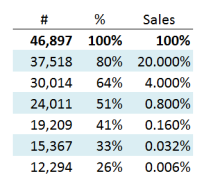Why Supply Chain innovation is unlikely to be appreciated
Alejandro Serrano – . Jun 2012 | Spain
When faced with the question “What is the name of the most innovative company in the world?”, people will most likely answer “Apple, of course”. The answer seems undeniable, and there are good reasons for that: iPhone, iPad, and iWhatever are synonyms of great innovative products these days.
However, there is a bias there; when people think about innovation, the first idea that comes to mind is product innovation. However, a company can gain a huge competitive advantage trough process or supply chain innovation. I am referring to notorious cases of companies who have completely redefined the way of doing business in their industries. Some examples include Benetton, which changed the sequence of operations by delaying the time where pieces of garment were dyed (postponement), or Barilla, one of the first firms to adopt VMI (Vendor managed inventory) by managing its customers’ inventory so as to reduce order variability amplification. These changes had a large impact on the bottom line and gave these firms a clear competitive advantage in front of their competitors.
The good thing about process innovation is that it may be hard for competitors to copy: there is no “product reverse engineering” to be performed. Competitors can and will try to emulate, but success is not by any means guaranteed. Think for instance about the well-known Toyota Production System (TPS). It has been around for about 40 years and still firms are trying to adopt it with bittersweet results. Why? It is simply that most of the changes cannot be seen, they are embedded in firms’ DNA, as pointed out by Spear and Bowen*, and followers just copy the visible part of it, such as Kanban systems in the case of TPS. A more recent example is Inditex, whose flagship Zara defined a new paradigm in a mature industry by betting on speed rather than cost. With more than 5,500 stores around the world, Inditex’s founder Amancio Ortega, is today the richest man in Europe, right before Ikea’s founder, Ingvar Kamprad, another visionary who also completely changed the rules of his industry.

- Source: http://www.eknowtion.com
This may not be the case for firms launching innovative products: Samsung’s Galaxy Tab is closely following Apple’s iPad and even introducing features which go beyond what the Apple product offers. It is true that patents help sometimes, but the fact remains that a burden of expensive legal work is usually triggered as soon as competitors start copying or including almost identical products in their portfolios. The legal battle triggered when Windows 95 was launched by Microsoft or the generic drug business in India may be good examples of this.
All in all, supply chain innovation is likely not to be appreciated as much as product innovation, but its impact on the financials and the value of firms may be larger and last longer. Also, given the relatively small efforts exerted so far on supply chain innovation, there must be indeed great opportunities available to explore, low hanging fruit to be taken by those smart people who are able to identify those opportunities.
(*) Spear, Steven and H. Kent Bowen. Decoding the DNA of Toyota. Harvard Business Review
To learn more about Supply Chain www.zlc.edu.es







